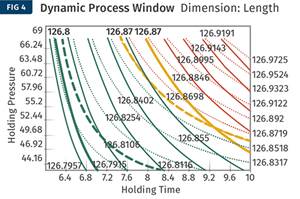Tiebarless Training Comes to Tennessee
Close-Up: Automotive
Automotive is booming in the state, and students are being prepared for jobs in molding.
A manufacturing education center and two new injection molding machines are doing their part in Tennessee to help feed that state’s voracious appetite for skilled plastics workers in its burgeoning automotive industry.
, York, Pa., furnished an 85-ton tiebarless victory spex and a 110-ton all-electric e-victory tiebarless machine for the in Pulaski as part of its revamped Advanced Manufacturing Program that’s busy readying workers for the region’s booming automotive sector.
General Motors, Nissan, and Volkswagen all build cars in the state, supported by parts suppliers like Denso, Calsonic Kansei, Yorozu Automotive, and M-Tek, with more companies on the way.
In the first quarter of 2015 alone, Denso, Unipres USA Inc., Nissan, Magneti Marelli, and Hicks Plastics announced investments in the state, which, according to the Tennessee Automotive Manufacturers Association (TAMA), employs 115,939 in auto manufacturing jobs at more than 1000 auto manufacturers and suppliers statewide.
To help those companies fill out their shifts, Tennessee has spent more than $80 million in automotive industry training since 2006, according to TAMA. Receiving a portion of that money is TCAT Pulaski. Located in south-central Tennessee, Pulaski sits 75 miles south of Nashville and 20 miles from the Alabama border.
TCAT Pulaski is one of 26 applied technology centers in Tennessee, part of a statewide system created in 1963. The centers’ Advanced Manufacturing Education offers students three career paths: robotics automation, PLC automation, and plastics injection molding. Students who complete the program are awarded an engineering technician diploma. The plastics engineering technician certificate comprises three labs and an internship/shop project totaling 1296 hr.
Dino Owen, Advanced Manufacturing Education (AME) Instructor at TCAT Pulaski, told Plastics Technology that the two new Engels will replace a hydraulic Nissei that had been used in training for 12 years. Owen said there are 17 students currently in the AME program, 10 of them on the injection molding track.
A recent lesson for those students was molding machine installation. Owen said the students assisted in rigging, leveling, and wiring the machines for their initial startup. The 85-ton press, which was purchased, and the 110-ton machine, which is on loan, will now ready those students for the molding world around them.
“Thanks to the Governor’s grant we received, our equipment was updated and technology advanced to meet employment needs of local 911±¬ÁĎÍř,” Owen says. “Students feel they are working with state-of-the-art equipment, which closely matches equipment used by growing companies within a 100-mile radius. Our goal is to help bridge the skills gap manufacturing is experiencing.”
Owen said that all students must complete hands-on projects focusing on areas like injection speed, transfer, pressure, temperature, and cycle optimization. Students working towards the Injection Molding Masters Diploma also study tool and die technology, including practice building insert molds, with instruction in draft angles, vents, waterlines, and part design. Students in the program build their molds in aluminum, with a recent project calling for 3D printing of a simple cavity. “Our record thus far is 20 parts from a plastic 3D-printed cavity,” Owen said.
Partnering on behalf of plastics training isn’t new for Engel, which over the last three years has also set up machines at Bradley University, Peoria, Ill. (30-ton hybrid e-victory); Clemson University, Clemson, S.C. (30-ton victory); and Nypro University in Clinton, Mass. (105-ton all-electric e-mac)
Related Content
Three Key Decisions for an Optimal Ejection System
When determining the best ejection option for a tool, molders must consider the ejector’s surface area, location and style.
Read MoreOptimizing Pack & Hold Times for Hot-Runner & Valve-Gated Molds
Using scientific procedures will help you put an end to all that time-consuming trial and error. Part 1 of 2.
Read MoreUsing Data to Pinpoint Cosmetic Defect Causes in Injection Molded Parts
Taking a step back and identifying the root cause of a cosmetic flaw can help molders focus on what corrective actions need to be taken.
Read MoreUse These 7 Parameters to Unravel the Melt Temperature Mystery
Despite its integral role in a stable process and consistent parts, true melt temperature in injection molding can be an enigma. Learning more about these seven parameters may help you solve the puzzle.
Read MoreRead Next
Lead the Conversation, Change the Conversation
Coverage of single-use plastics can be both misleading and demoralizing. Here are 10 tips for changing the perception of the plastics industry at your company and in your community.
Read MoreFor PLASTICS' CEO Seaholm, NPE to Shine Light on Sustainability Successes
With advocacy, communication and sustainability as three main pillars, Seaholm leads a trade association to NPE that ‘is more active today than we have ever been.’
Read MorePeople 4.0 – How to Get Buy-In from Your Staff for Industry 4.0 Systems
Implementing a production monitoring system as the foundation of a ‘smart factory’ is about integrating people with new technology as much as it is about integrating machines and computers. Here are tips from a company that has gone through the process.
Read More














